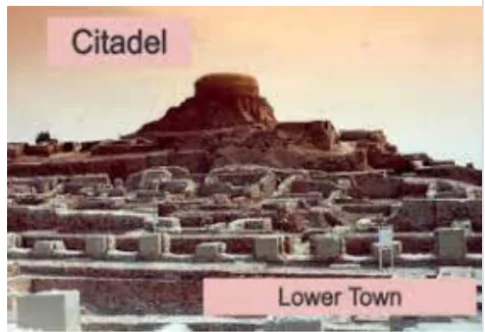Introduction
Architecture basically means the art and science of designing structures. Indian architecture is rooted in the history, culture, and religion of India. The earliest remains of Indian architecture are to be found in Harappa, Mohenjodaro, Ropar, Kalibangan, Lothal and Rangpur.
Key Features of Indus Valley Civilisation
- Grid Pattern: The towns of this civilisation were laid out in a rectangular grid pattern with roads cutting each other at the right angles.
 Burnt Bricks: They used burnt mud bricks of standardized dimensions and layers of bricks were joined together using gypsum mortar.
Burnt Bricks: They used burnt mud bricks of standardized dimensions and layers of bricks were joined together using gypsum mortar.- Drainage System: The cities were equipped with an advanced drainage system with small drains from each house connected to a bigger drain.
- The drains were covered loosely to allow regular cleaning and maintenance.
- Cess pits at regular intervals and the presence of wells were also observed.
- Granaries: Had strategic air ducts and raised platforms to protect from pests.
- Great Bath: From Mohenjodaro was equipped with galleries and rooms indicating the importance of ritual cleansing.
- Division of Cities: The cities were divided into two divisions:
Enroll now for UPSC Online Course
| CITADEL |
LOWER TOWN |
- Located in the western part.
- Smaller than lower town.
- Hosted large buildings like granaries, administrative buildings, pillared halls, residences of the rulers and aristocrats, courtyards etc.
|
- Located in the eastern part.
- Larger than the citadel.
- Contained small one-roomed houses, probably for working-class people.
|
Conclusion
- The architectural marvels of the Indus Valley Civilization, including planned cities, intricate drainage systems, and monumental structures, stand as enduring testaments to the ingenuity and sophistication of ancient urban societies.
![]() June 7, 2024
June 7, 2024
![]() 3267
3267
![]() 0
0
 Burnt Bricks: They used burnt mud bricks of standardized dimensions and layers of bricks were joined together using gypsum mortar.
Burnt Bricks: They used burnt mud bricks of standardized dimensions and layers of bricks were joined together using gypsum mortar.